本文共 7913 字,大约阅读时间需要 26 分钟。

When you have massive amounts of data and the need for data analytics, or you have high availability requirements, or security and backup protocols to follow, services like Alibaba Cloud's HybridDB for PostgreSQL can come in handy.
The service takes powerful Relational Database Management Systems (RDBMS) to a whole new level. In this article, we are going to explore how to get started with Alibaba Cloud's HybridDB for PostgreSQL service—for free.
PostgreSQL
PostgreSQL (also known as Postgres) is considered the most advanced open-source database, for several reasons. In the old world of databases—systems that organize, describe, store, structure and let users query data—there are several players that require costly licensing agreements. But there are also some players that deliver an interesting balance between features—and now, scaling. Postgres, with the help of Alibaba Cloud HybridDB, is one of these.
Postgres is formally a RDBMS, which means that it solves the problem of organizing data based on the relational model invented by Edgar Codd. Since version 8.0 launched in 2005, it has evolved to cover new spaces—including some non-structured data—and now, in version 10, launched this year, Postgres offers:
● XML data types, which let you store XML documents as columns of a table, query tags and attributes, convert to-from XML, and more
● JSON data types, allowing storage of JSON documents as columns of a table, queries of documents, conversion to/from JSON, the addition of indexes to improve performance, and more● HStore data types, meaning that you can define key-value columns in the tables ● GIS extensions, allowing specialized datatypes, indexes, and a bunch of utilities for GeoSpatial use cases● Basic full-text search capabilities● Query parallelizationThe last one is special because it makes available to the local developer (and usually the dev environment) the capacity to launch complicated queries which will be optimized to run in parallel, using the full capabilities of multiple core processors. But how is the same thing accomplished when the amount of data is in the order of terabytes, or petabytes? It's called Massive Parallel Processing—and one solution is to use a cluster of databases that can share the load and offer one single interface that looks as if it were a single database instance.
From the database world to the cloud
Running a database cluster is a complicated task, and usually, there is a specific role (better, a specific team) in the company that handles this. There are innumerable important details and a huge amount of subtasks that you need to handle to offer a reliable, scalable and blazing fast service. Fortunately, companies like Alibaba Cloud offer this kind of service, and you can jump from zero to a decent cluster configuration without being a specialist.
The open source project is a Massive Parallel Processing Database based on PostgreSQL 8.2. Alibaba Cloud's HybridDB is one cloud provider that offers a service to run Greenplum and manage tasks such as security and backup. What are the advantages?
Here are a few:● Autoscaling
● Simplified management● Isolation of the environment using virtual private clouds● Exclusive extensions to the Greenplum base implementation, such as JSON and HyperLogLog ● Support of Open Storage Service● Support of migration tools such as pgsql2pgsql (PostgreSQL to PostgreSQL) or mysql2pgsql (MySQL to PostgreSQL) ● Support for SQL-99, SQL-03, SQL-08 standards● Support of the projectThe last one is particularly interesting because it extends HybridDB for PostgreSQL with "data-parallel implementations of mathematical, statistical and machine learning methods for structured and unstructured data," which means that you will be able to do advanced analytics on data locally, in-database.
Hands-on
Let's take a look at this solution by creating an account at , and taking advantage of the $300 (USD) credit that they offer for new users. (The registration process is simple, so it will not be explained in detail here.) The idea is that you create an instance which is a compound of groups of databases (at least 2) that will share the same CPU, IO, memory, and disk resources. (Keep in mind that the resources in one group are allocated to the same physical host.) Go to the console and click on "HybridDB for PostgreSQL":
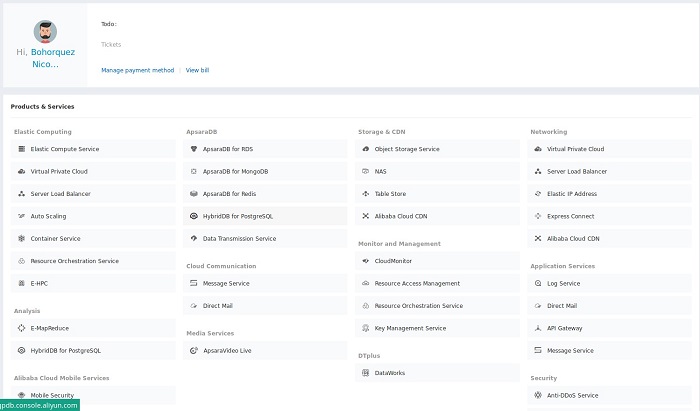
Click on the button in the upper-right corner labeled "Create an Instance":

Select the Region, Zone and Instance Class:
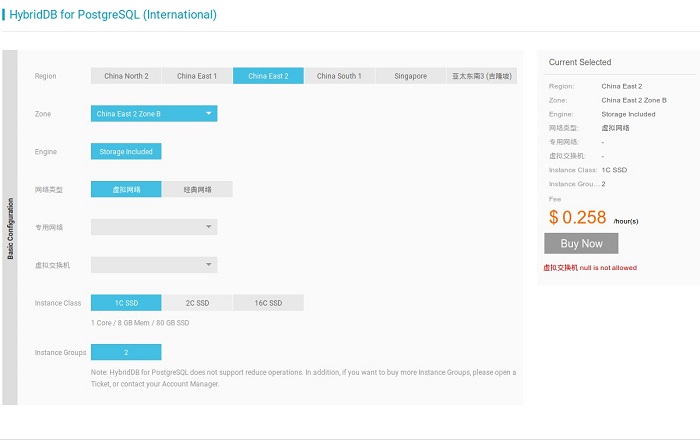
Confirm your order:
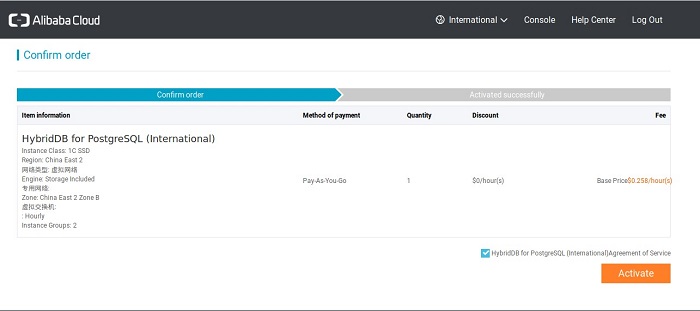
After a few seconds, your instance will be created. Then, click on the "Manage" link at the end of the row:

We are going to configure access to the instance through the Internet because this is just a sample. (This setup is highly risky, and you should avoid it in your project's setup. Please read the security guides and collaborate with your IT security team before configuring an instance.)
Next, click on the link "Security Controls" on the left panel, and create a new white list group by clicking the "Add White List Group" button on the right. Call it "internet" with the white list set to "%" (which means any IP address):
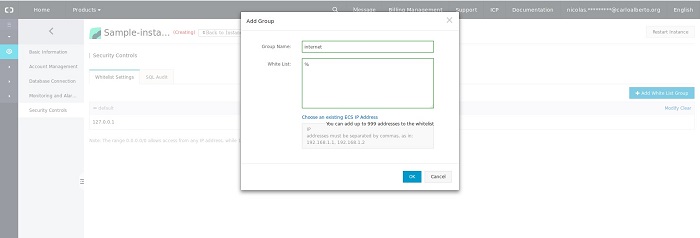
After the security (mis) configuration is complete, we are going to create a new database user account. Click on the "Account Management" link on the left panel, and then the "Create account button":
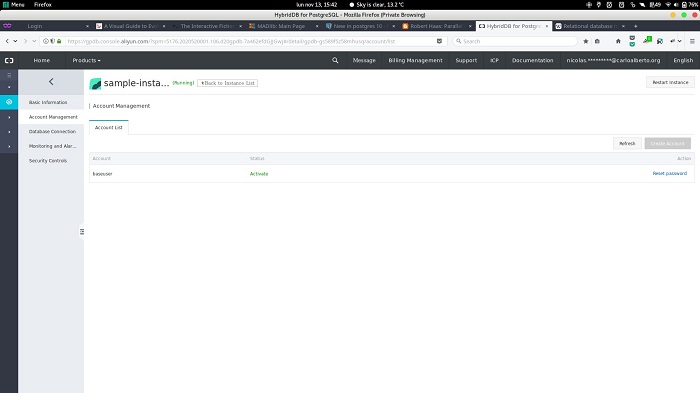
Fill in the details. Your password must contain uppercase and lowercase letters, symbols and numbers. (If you forget the password, you can reset it from the console.) Click the "OK" button. In order to get an Internet address for the instance, click on the "Database Connection" link on the left panel, and click the button "Apply for Internet address." (Again, this IS NOT A RECOMMENDED practice as it is highly risky.)

Now we are going to test the setup using PgAdmin III as the client. (You can use JDBC, ODBC, PSQL, Python, libpq, etc.) Register a new server and fill in the details. Pay special attention to the "Host"— yourgpdbaddress.gpdb.rds.aliyuncs.com; "Port"— shown at the instance details console—along with the "Username" and "Password" that you have already configured, and click the "OK" button:
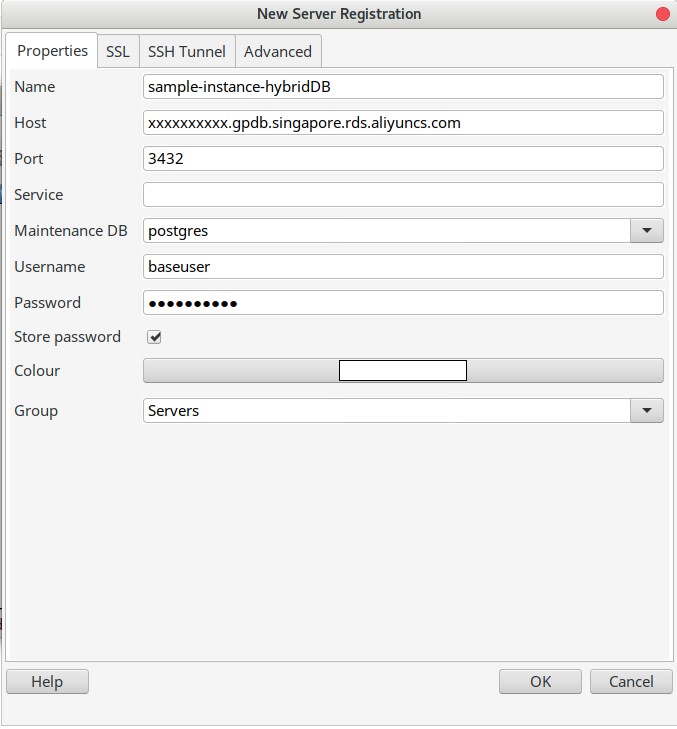
After the setup, you can import your data with OSS, mysql2pgsql, pgsql2pgsql, or another tool, and start playing. Don't forget to check out the about the capabilities of the Greenplum project and the extensions supported by Alibaba Cloud's HybridDB for PostgreSQL.
Alternatives
There are multiple approaches to achieving Massive Parallel Processing. HybridDB is one of them, but the market offers additional alternatives such as CitusData, Snowflake Cloud Data Warehouse, and Amazon Redshift, among others. If you have a use case that will benefit from a MPP solution, choose your provider wisely.
Final words
With a little effort, and after reading some documentation, it's pretty simple to set up a basic database cluster using Alibaba Cloud's HybridDB for PostgreSQL. The console and management services are simple and intuitive. The ability to set up the environment for Massive Parallel Processing solutions with a few clicks, keeping compatibility with one of the most advanced database engines and useful extensions, certainly looks very promising, but there are some points that could use some polishing, like the localization of management tools and the written documentation. It is always good to have more alternatives to tackle new Big Data quests.
To try Alibaba Cloud for free, you can take advantage of their current offer of .
Bio
Nicolas Bohorquez (@Nickmancol) is a software developer from Colombia and is currently earning a Master's in Data Science for Complex Economic Systems at the Collegio Carlo Alberto in Turin, Italy. Previously, Nicolas has been part of development teams in a handful of startups, and has founded three companies in the Americas. He is passionate about the modeling of complexity and the use of data science to improve the world.c
转载地址:http://nnjio.baihongyu.com/